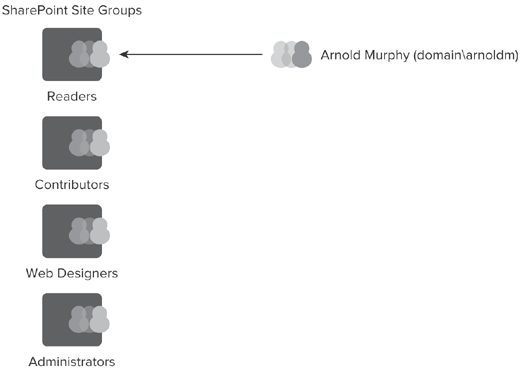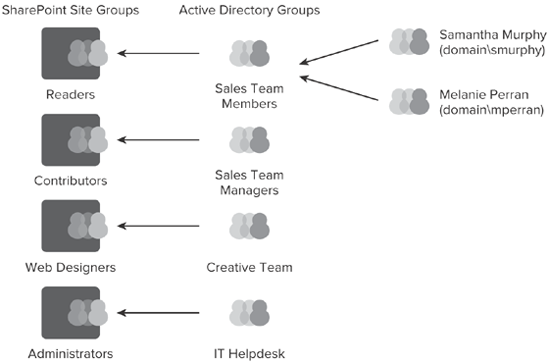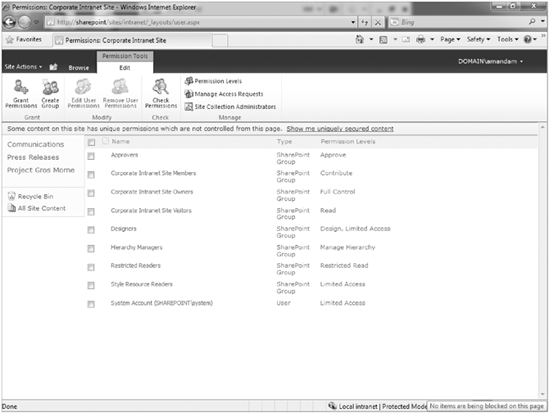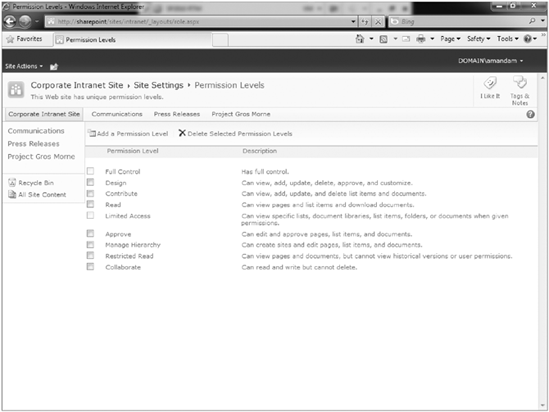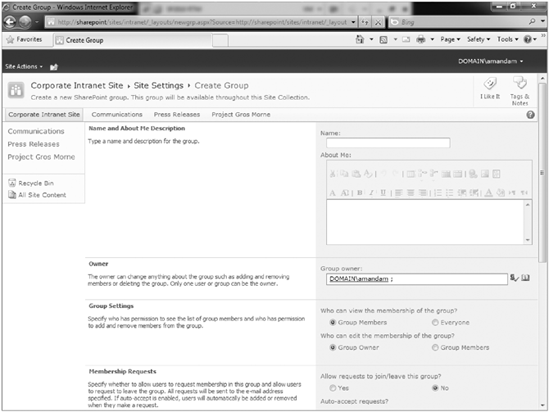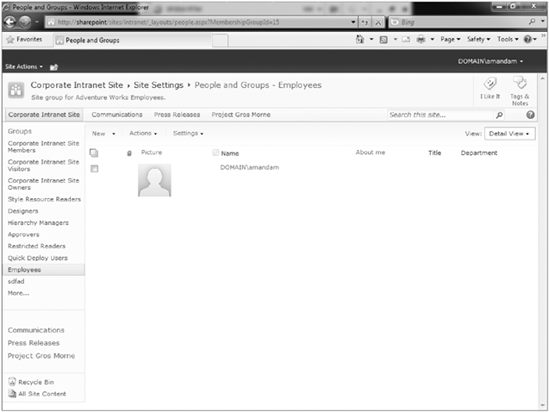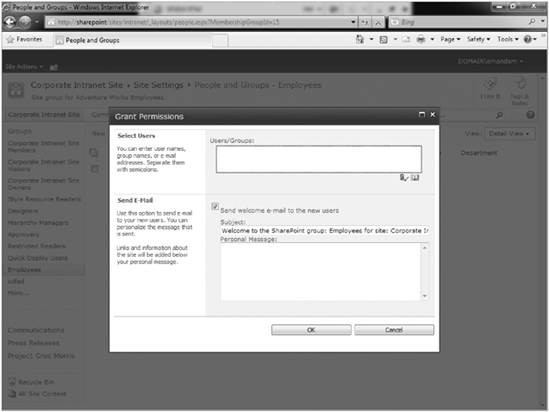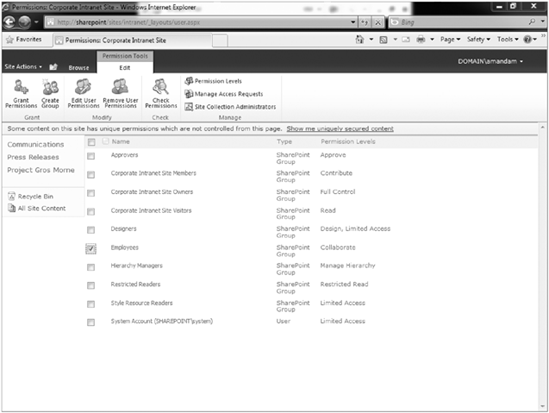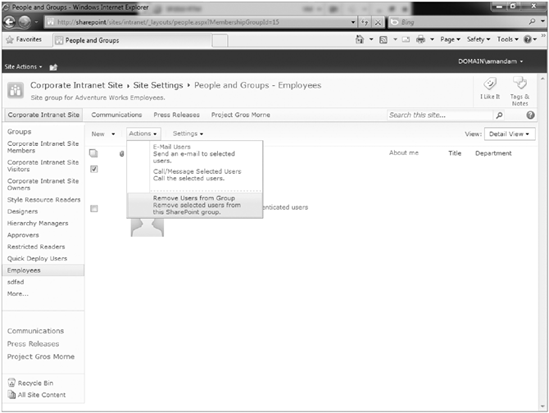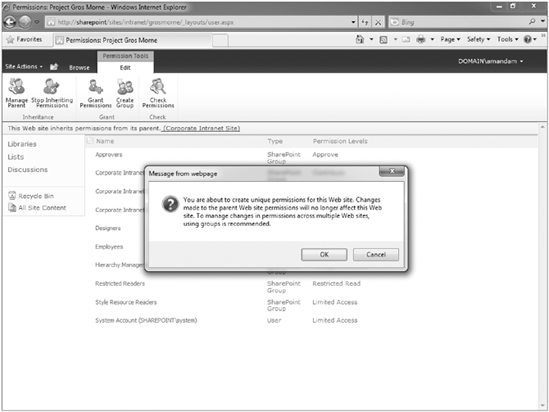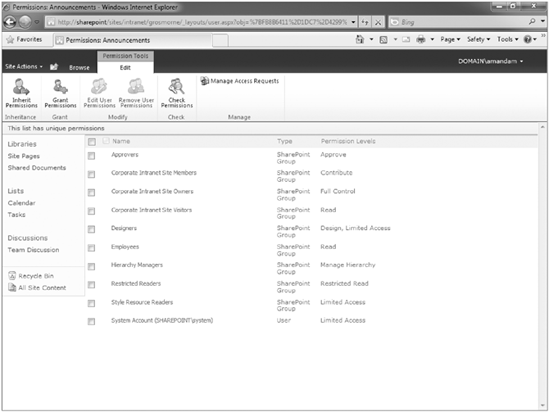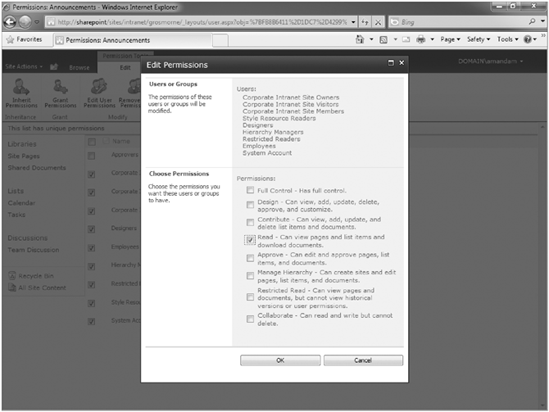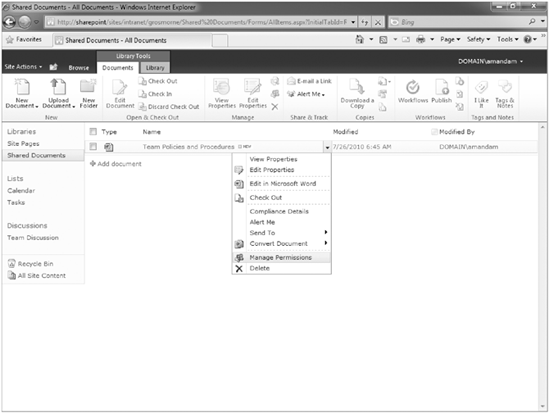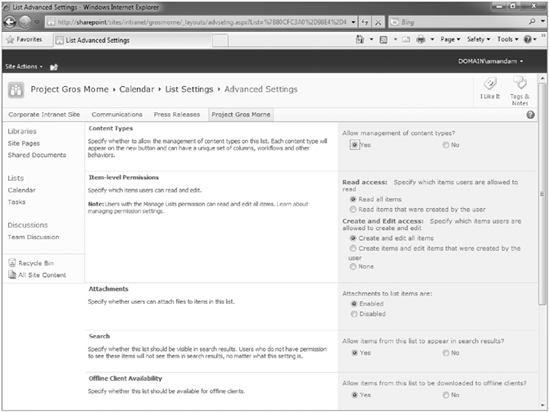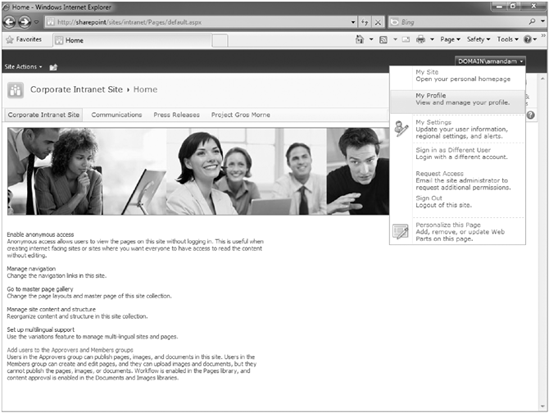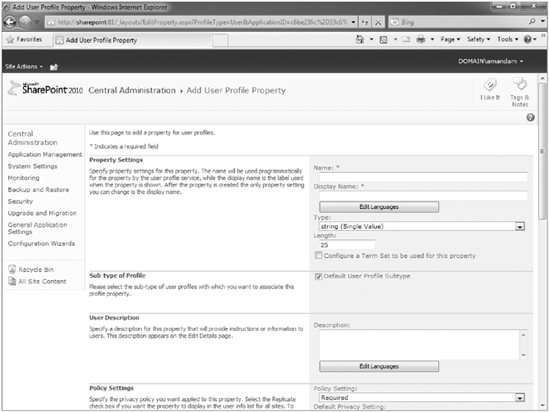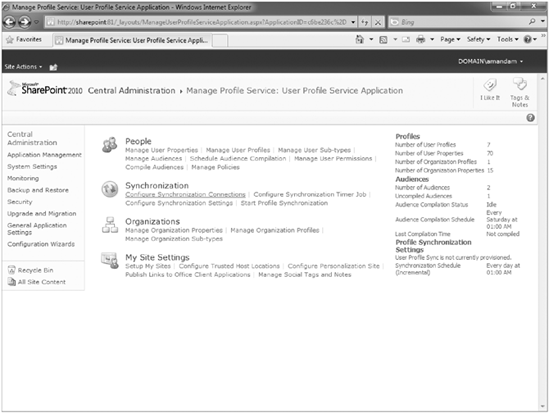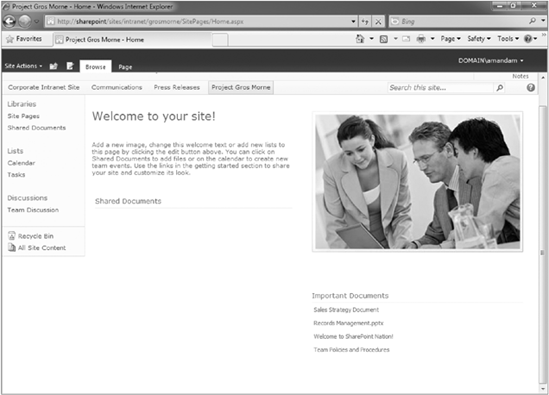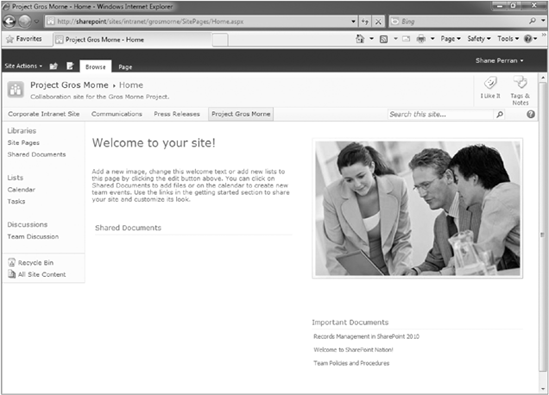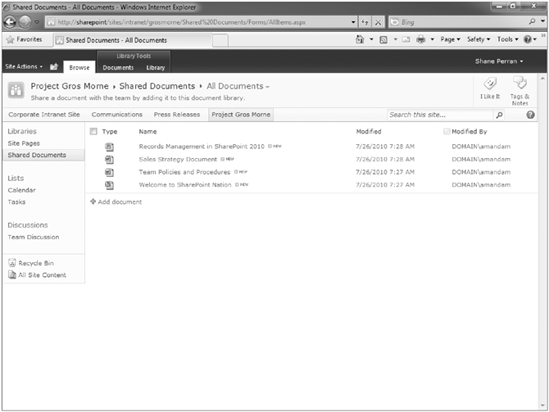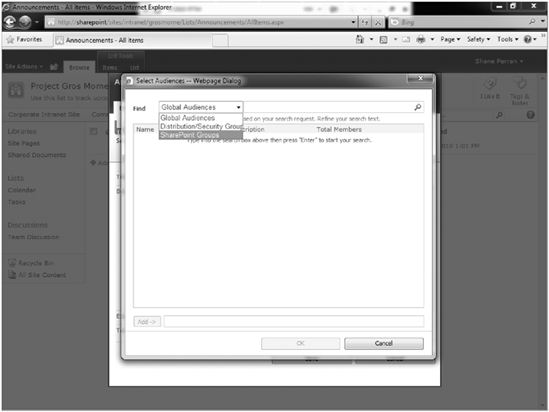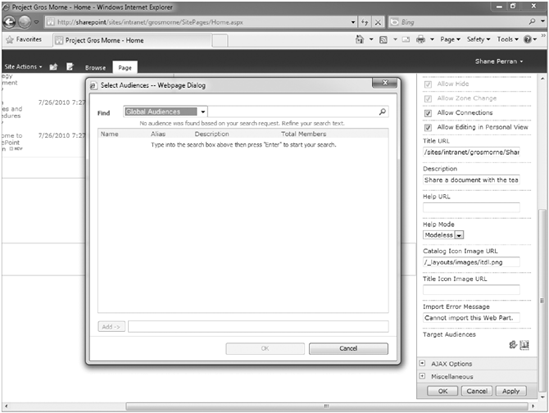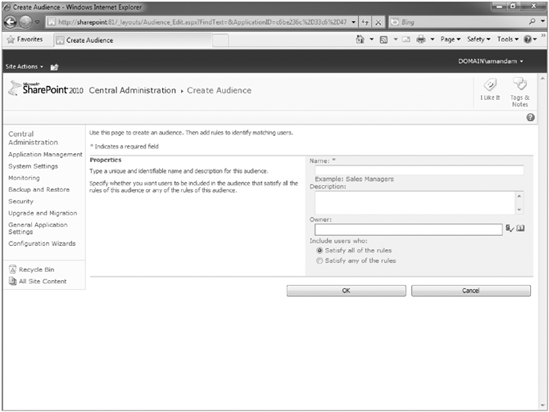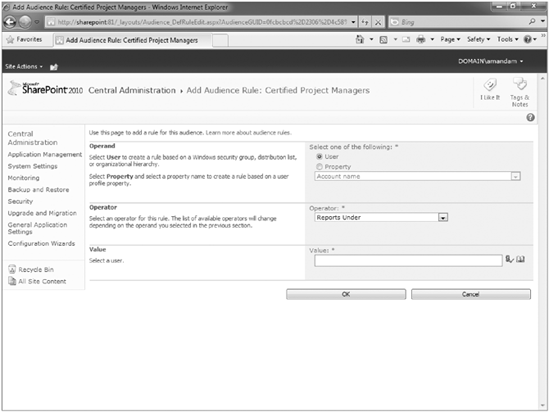WHAT YOU WILL LEARN IN THIS CHAPTER:
The difference between user access and personalization
The different permission levels in a SharePoint site
SharePoint site groups and the built-in ones you can use
How to update user profile information manually and automatically
How to create audiences based on specific memberships or profile properties
How to target information and web parts to specific audiences
So far in this book, you've read a lot about how to work with SharePoint content and the various components you can create and customize. Unfortunately, none of your work with these topics means anything unless your users can quickly access that content, and configuring access to that information has a lot to do with how much of it there is and where it's located. Just because users have access to content does not mean that they have a requirement to see the content. It's important to evaluate the content that will be stored in your information system and determine how users will need to access and view it. You may need to do this by asking some important questions: Do you have too little information? Do you have so much information that a user can't wade through it? Where is your information located? Do you have one location in which to store information or do you have information located throughout a hierarchy? Can users easily access the information they need to perform their jobs? Is the content they view relevant to them?
After reading this chapter, you should feel comfortable planning and implementing changes to your SharePoint environment to ensure that users can access content relevant to them.
Before you learn how to manage access to any SharePoint site, you need to understand two very important concepts in SharePoint related to the users who connect to your sites:
Understanding these concepts helps you learn how to effectively manage a site, protect the site's integrity from users who shouldn't have access to certain information, and make the user experience as productive and problem-free as possible.
Imagine you work for a company where users from around the globe share information related to their various business activities. There are different divisions such as Sales, Marketing, Finance, and Legal. Members of a specific division can log in to their portal site and stay up to date on projects and initiatives, as well as work with others in their divisions and teams. For this to happen effectively, you must configure the SharePoint environment to support the following:
User access management: These are the rules that determine what a user can do on a site. To ensure that users can only access the content they need to perform their work, you apply permissions to each divisional site. Within a specific division, users may have different roles and privileges. For example, some users only view content, while others can add or approve new content.
Personalization: This ensures that content is relevant to the users of a site. You use personalization and audience features to do this. Personalization is allowing users to only view content that is relevant to them. You may accomplish this by providing them the ability to customize the interface to only display items that are of interest to them, or it may mean creating certain views that only display items where a person's username is displayed in a specific column, such as the Assigned to column. In some cases, you may want to target specific content elements, such as a document, list item, or web part, to members of a role. Through audiences, you can identify the groups of people that would find information relevant as you publish it. Perhaps in the Sales division, for example, certain promotions and sales procedures are only relevant for the North American region, and are distracting to sales personnel from the other regions. Therefore, when publishing these promotional documents, the content manager would select a North American audience.
Before you try to personalize content, it's very important that you solidify the underlying content access. With that in mind, the chapter covers user access features of SharePoint first, and then discusses audiences and other personalization features in greater detail.
When users click a link or enter the web address of a SharePoint site, they are either logged in to the site automatically because they are already authenticated on the site due to the configuration of their network or they are prompted for a username and password via a dialog box or form. In some cases, there may be no need for authentication because the site is configured for anonymous access. For this chapter, you will primarily review scenarios where the user is connecting in an authenticated environment.
Once users are logged in to the site, they will only see content and user interface elements that they have been given permission to view. The content that users view and edit is determined by their SharePoint site group membership and permission levels. Site groups are specific roles in SharePoint that determine what a user can do within a site. Permission levels define the activities that a user or group is allowed to perform in a specified location.
Note
For more on the different site groups and permission levels, see the section "Working with Site Groups and Permission Levels."
Most organizations using SharePoint in a corporate or enterprise setting, such as an intranet, will use Active Directory to manage user profiles and determine how users log in to the network, which is also known as the authentication process. If your organization uses Active Directory, SharePoint becomes a great browser-based tool in which to work because a user who logs in to the domain does not typically need to enter credentials again to access a SharePoint site. This is because when the system administrator configured the SharePoint server, it was added as a member of your Active Directory domain. Therefore, when you enter your username and password to connect to the network, the SharePoint environment will recognize you as a member and, therefore, not require you to specify your username and password again. In addition, SharePoint will allow you to connect to sites based on your site group membership and will retain your permissions as you access various other Windows-based systems such as file shares or printers. Most users prefer this type of experience because it can be tedious and confusing to manage both multiple usernames and passwords.
A site manager can add specific Active Directory users to a site group by typing their names or email addresses into the site membership interface. See Figure 10-1 for an example of how this can work.
However, in organizations with thousands of users, it's more realistic to add Active Directory security groups to a SharePoint site group. This not only reduces administrative overhead when you first set up a site but also means the site's membership stays up to date as new users join or leave the organization. As you add users to the Active Directory security group, they are automatically assigned to the SharePoint site group that has been associated with the security group, as shown in Figure 10-2.
The rest of this chapter looks at specific access and authentication examples based on an underlying assumption that Active Directory is the primary membership store.
As your SharePoint environment starts to become populated with important business documents, it's important to manage access properly. Users who require information to do their jobs should be able to easily locate and then access information. In cases where you have sensitive information on the portal, it's crucial that only users who have a business requirement to access it have the rights to do so. Finally, because SharePoint will become a central storage location for important business information, it is critical that this information be protected. This means locking out those who could cause harm to the system or should not have access to information.
A permission level represents a set of rights that can be assigned to a user or group on a specific SharePoint object such as site, list, or document. Out of the box, several permission levels exist to reflect the most common usage scenarios of the system; however, you can create custom permission levels to meet your specific requirements.
Note
It is not recommended to ever change the out-of-the-box permission levels; rather, create new permission levels to match your specific needs. By modifying the out-of-the-box permission levels you may run the risk of creating an environment that is difficult to identify and control exactly what rights users have.
The table below outlines the default out-of-the-box permission levels in SharePoint 2010.
A SharePoint site group defines the membership of a specific role within an organization. The following list shows the different types of site groups that SharePoint has to offer out of the box. Depending on which site you create, you may notice all of these groups or a subset of them. However a better practice in real-life scenarios is to create custom groups that reflect your organization's structure.
Now that you have an understanding of the various SharePoint site groups and permission levels, let's take a look at some of the ways you can manage access to the content stored with sites by working with the site groups and permission levels. This section looks at how you can create your own site groups as well as change the access rights of a user or group by changing their existing permissions. You also learn how to control how users request access changes related to your site.
In the next Try It Out, you will create a site group called Employees to represent the employees of your organization, and you will assign the newly created permission level to that group. You then add new team members to your site group. If you find later that you need to change permissions on a group or user that you've already created, or totally remove a user altogether, you learn to do so in the third and fourth Try It Outs. In the last Try It Out of the section, you find out how to enable access to a site when a user requests it.
Everything you've learned so far has been related to controlling access and rights on a SharePoint site. However, SharePoint also supports permissions management on the list and item level. This means that, while a user may contribute to his team's collaborative site, he may only be a reader for a particular document library or even a single document in a library. This section discusses the different levels of access that you can have on a SharePoint site.
Each of the examples thus far in this chapter has applied to managing access at the site level because, by default, this is the level where access is defined. From a restriction standpoint, you do not want to overcomplicate access and you want to keep things simple unless your requirements dictate otherwise.
When you work on a site level, you need to determine whether you want a subsite to inherit permissions from a parent site or not. Your decision generally depends on your requirements:
Inheriting permissions: When you inherit permissions from a parent site, you create a scenario in which any user who has permission to the parent site will have the same permissions and rights on the child site. This cuts down on the tasks and effort associated with managing permissions and creates a consistent access experience for all users.
Creating unique permissions: Creating a site with unique permissions will allow you to manage permissions and access to your child site, independent of the settings specified for the parent site. Therefore, a user who can add content on the parent site may not necessarily have access to the child site. Users perform different roles from site to site. This means that you'll have to spend more time setting up and managing the site, but you will have greater flexibility in meeting the access requirements of each individual team. Sometimes it's beneficial to give users greater access rights on a subsite than they have on a parent site. For example, in a sales proposal workspace, members of the sales team may be able to create lists and libraries to aid in their production of the proposal, whereas on the sales team site they may only have permissions to add content to existing lists.
Sometimes a list or library on a team site requires a different set of permissions than the rest of the site. For example, a document library containing sensitive financial performance reports should not be shared with everyone who has access to the site. You could create a separate site to store this information, but it's easier to simply adjust the permissions on the library so that a subset of users can access the library. Another example is where only certain users can edit a specific list or library in which team members can only view content. For example, only a manager can create new items on an Announcements list for a team, but team members can contribute to list and libraries on the rest of the site.
By default, access to an individual list item is inherited from the list or library in which it resides. However, you may need to better define this. For example, storing a policies and procedures document within a team's shared documents library means anyone can contribute to it and add contents; however, for legal reasons, only certain managers should have the right to edit it. You can restrict access to one document, even if it resides in a list or library to which everyone has access, as shown in the next Try It Out. In a second Try It Out, you learn how to limit access to a list so that users may only view or edit items that they have created themselves.
SharePoint Server has a special database that can store information about the users of the system, called the user profile database. This database contains properties and metadata about each user of the system in a very similar manner to that in which you can store information describing a document in a document library. User profile information is useful for storing contact information and biographies of the different users of the system for information-sharing purposes, but you can also use it for more advanced purposes, such as content targeting and personalization via audiences (discussed in a later section of this chapter).
While SharePoint can import profiles from other sources, this chapter assumes that Active Directory is your primary profile source because it is the most common identity store for organizations using this application. SharePoint maps user profile properties to common profile properties from Active Directory, including Name, Email Address, Phone Number, Manager, and Address. SharePoint can also import custom profile properties such as skills, languages, and employee ID.
In addition to importing information from Active Directory, SharePoint can obtain user information from the following sources that can augment user profiles with additional information:
User profiles are not required for an organization to implement SharePoint; however, they allow you to personalize information, including profile information to share with coworkers. For example, each SharePoint user can create a My Site, where he or she can store personal or shared files, view organizational content, write a personal weblog, and maintain his or her own profile properties. You can create a personal site by selecting the My Site link from the personalization menu of any page or site in the portal, as shown in Figure 10-18.
Each My Site has an area known as My Profile, where users can share information about themselves. By sharing more details on personal sites and profiles, workers can get to know each other better, which helps in situations where employees work for the same company but in different buildings.
From the Public Profile page, you can view a variety of information about an employee including:
An image of the employee
Contact information
Documents that the employee has shared
Information on who the employee reports to and any other employees who report to them
Things that the employee has in common with you based on profile properties such as languages, skills, or schools
Tags and Notes that the user has created
Colleagues
An example of a public profile page is shown below in Figure 10-19.
Because profile properties are indexed and searchable, you can search for a specific property and find a list of people who have that property assigned to them. For example, if you are a manager looking for a computer programmer with ASP.NET experience to build a custom web part for your SharePoint site, you can use the People search scope to search for ASP.NET to receive a list of people in your organization who have that skill. When you click their names, you are redirected to their personal site, where you can find out who their manager is (in case you want to contact the manager) and what previous projects the employees have worked son.
Although you can import some profile properties from primary membership systems such as Active Directory, users can update others themselves via their My Site. This helps keep information up to date and relevant. The server administrator decides what profile properties a user can update. A user can also select from the following choices on who can view information that is stored in specific properties:
For example, something such as skills or schools would be shared with Everyone, while a home phone number would only be viewable by a manager. The following Try It Outs illustrate how users can update their own profile properties via their personal site. In the event you have a specific detail that you want a user to provide on the site, for example, specific professional experience, certification, or attended business seminars, you can add a new user profile property.
Many of the remaining exercises of this chapter are based on the assumption that you are working in a SharePoint Environment where the User Profile Server Application has been configured for use. Please confirm with your system administrator that this has been configured properly. While this topic is considered outside the scope of this book, details related to the configuration of this Service Application are available here: http://technet.microsoft.com/en-us/library/ee721050.aspx
You import user profiles into SharePoint on a scheduled basis and can do so from single or multiple sources. In cases where you are importing profile information from more than one database, you must have a master connection, which is either Active Directory or another LDAP server and a secondary connection, which isa Business Connectivity Services application.
You configure connection synchronization settings from the Manage Profile Service page. You can access this site from the Manage Service Applications page by selecting the User Profile Service Application and clicking the Manage button from the Ribbon.
If no synchronization connection exists, you must create a new connection under the Configure Synchronization Connections link, as shown in Figure 10-23.
From the Manage User Permissions section, you may specify permissions for a variety of personalization services, such as:
Create personal site
Use personal features
Use social features
An audience is a special group to which content is targeted so that only people in that audience see it. A user becomes a part of an audience based on profile properties or membership to a distribution list or SharePoint site. Audience content targeting should not be confused with access. Just because users cannot see an item does not necessarily mean that they do not have access to the item. An audience may exist for members of an organization that work out of a certain region such as Canada. Therefore, if you assign the audience to an announcement related to a special event taking place at the Canadian office, it will be seen only by members of that audience. The following sections give some examples of how you can use audiences.
You can configure certain web parts such as the Content Query web part, discussed in Chapter 7, to support audience filtering. This means that when you display multiple items in a web part, users will only see those that are targeted to them. Figures 10-24 and 10-25 demonstrate examples of filtering list information by audience via a Content Query web part. Figure 10-24 is what the team site main page looks like to a member of the sales team audience, who can view the Sales Strategy document because it's targeted to their audience. Figure 10-25 shows the same site page as viewed by someone who is not a member of the sales team audience. Notice the user does not see the Sales Strategy document even though it exists in the library.
If the user who isn't in the sales team audience were to click the Shared Documents library, he or she could still see the document listed in the view, as shown in Figure 10-26. This is because the Content Query web part filters items so that they are only displayed to targeted audiences and the standard list web parts are not. All web parts, however, allow you to target the contents of an entire web part to an audience.
More than likely, your organization has already made significant investments in Active Directory, which groups people based on their roles as well as the organization's communication requirements. So instead of creating audiences, which you need to manage and maintain as an extra layer in the SharePoint environment, you can take advantage of existing objects, such as Windows Distribution Lists or Security Groups. In fact, your organization probably has a distribution list on your Exchange mail server for the sales team that keeps them informed of product updates and sales promotions. You can use the distribution list as an audience and target content from the SharePoint environment directly to the audience's members. As announcements are added to the corporate portal, the audience can see and, thus, view the latest news as soon as they log on. If the organization is fairly busy and generates numerous new announcements each day, the use of audiences helps users "separate the wheat from the chaff."
The next two Try It Outs show you the process of managing a membership-based audience. The first Try It Out shows you how to target an item to a distribution list so your audience can keep up to date on new promotions and other information via a central portal page. This is useful for sales teams, who, because they travel and work remotely, have limited time and need to view content directly related to them. The next Try It Out shows you how to target specific list items, documents, or even entire web part content to an audience by creating audiences based on membership to SharePoint site groups.
All examples of the audience creation process so far have been based on either Active Directory or SharePoint-based groups. This chapter now discusses how audiences are created based on properties from the user profiles. When you consider that the profile can contain information not only from Active Directory (or another LDAP server) but also from other business applications, such as a human resources or financial database, you can see that the possibilities for how specifically you can target content are endless. By using personal profile properties, you can make audiences very detailed to the point of defining audiences for specific topics. For example, you can create a profile property called News and Promotions that has a value list from which users can select via their profile to identify what products they want to receive promotional updates on.
In the following example, you see how to create an audience based on the property you created earlier in the chapter for certifications in the Try It Out "Adding a New User Profile Property." If you recall, this field gives users a place to update their own certifications from their My Site. However, it is equally as possible for you to automatically update this profile property from an external system, such as Active Directory or a central human resources database.
This chapter discussed two important concepts related to information management: user access and personalization. User access is the way you can control who can view, edit, or create content in a SharePoint environment. You can define access on the site level, document library, or list level through permission levels and site groups. For lists, you can also define rules for what content users can read or edit at the item level.
As a general rule, you should use existing Active Directory groups and objects when you assign permissions to specific roles in a SharePoint group. In most organizations, Active Directory is kept up to date as employees change positions, leave, or are hired. By creating a relationship between Active Directory and SharePoint site groups, you automatically keep user membership current without relying on manual updates.
Personalization in SharePoint is delivered via functions such as user profiles, audiences, and My Sites. When you use personalization features, users are only exposed to content that is relevant to them. Profile properties and My Sites also help encourage users to learn more about each other and interact with one another. In many organizations, users do not connect with one another because of a lack of awareness of what they have in common with one another or who has what skills.
When defining personal profile properties, users can determine if everyone, their colleagues, their manager, teams, or only the user can view information. This helps create a network of professional and personal information sharing that is controlled and secure so that users feel comfortable sharing specific details and know that these details will only be shared with the appropriate audience.
This chapter also discussed how you can create audiences to identify groups of users who share common profile properties, group memberships, or characteristics. Once an audience is created, content from the SharePoint site can be targeted at them. The more audiences are used for content, the more relevant the user experience becomes.
WHAT YOU LEARNED IN THIS CHAPTER
TOPIC | KEY CONCEPTS |
|---|---|
What is a SharePoint Group? | A SharePoint group is a role defined to which users can be added. These groups can then be assigned specific rights and permissions to different elements within SharePoint. |
What is a Permission level? | A permission level is a set of rights that can be assigned to a user or group in SharePoint. |
What is an Audience? | An audience is a group of people that share common characteristics. Content or web parts may be targeted at specific audiences so that when members of that audience view a page, the content will be visible to them but not to users that are not members of the audience. This helps create a relevant user experience for site members as they only see information that has been targeted to their role. |

